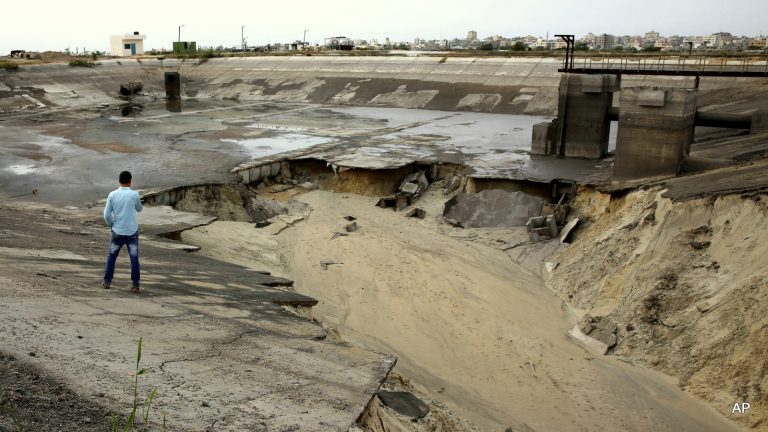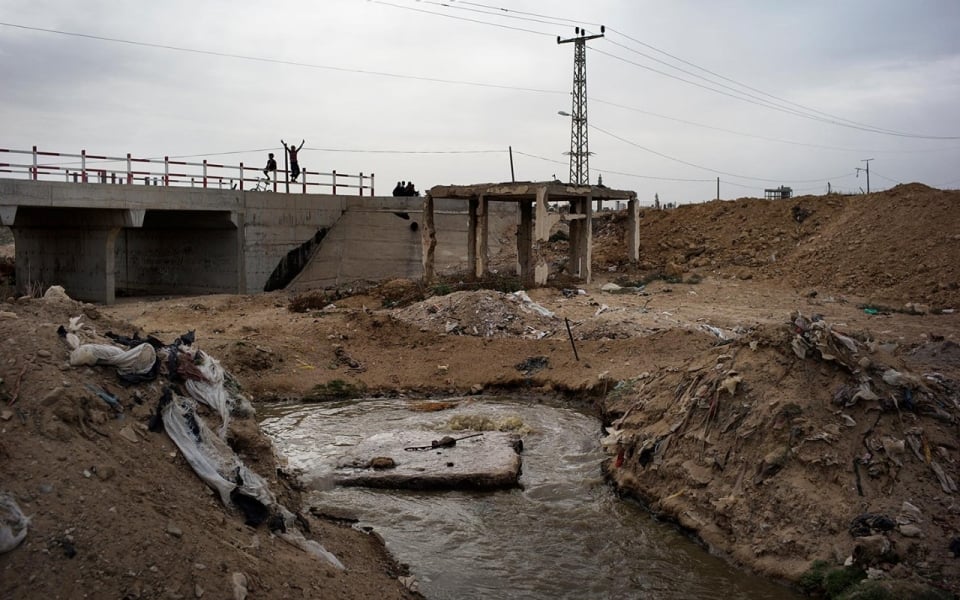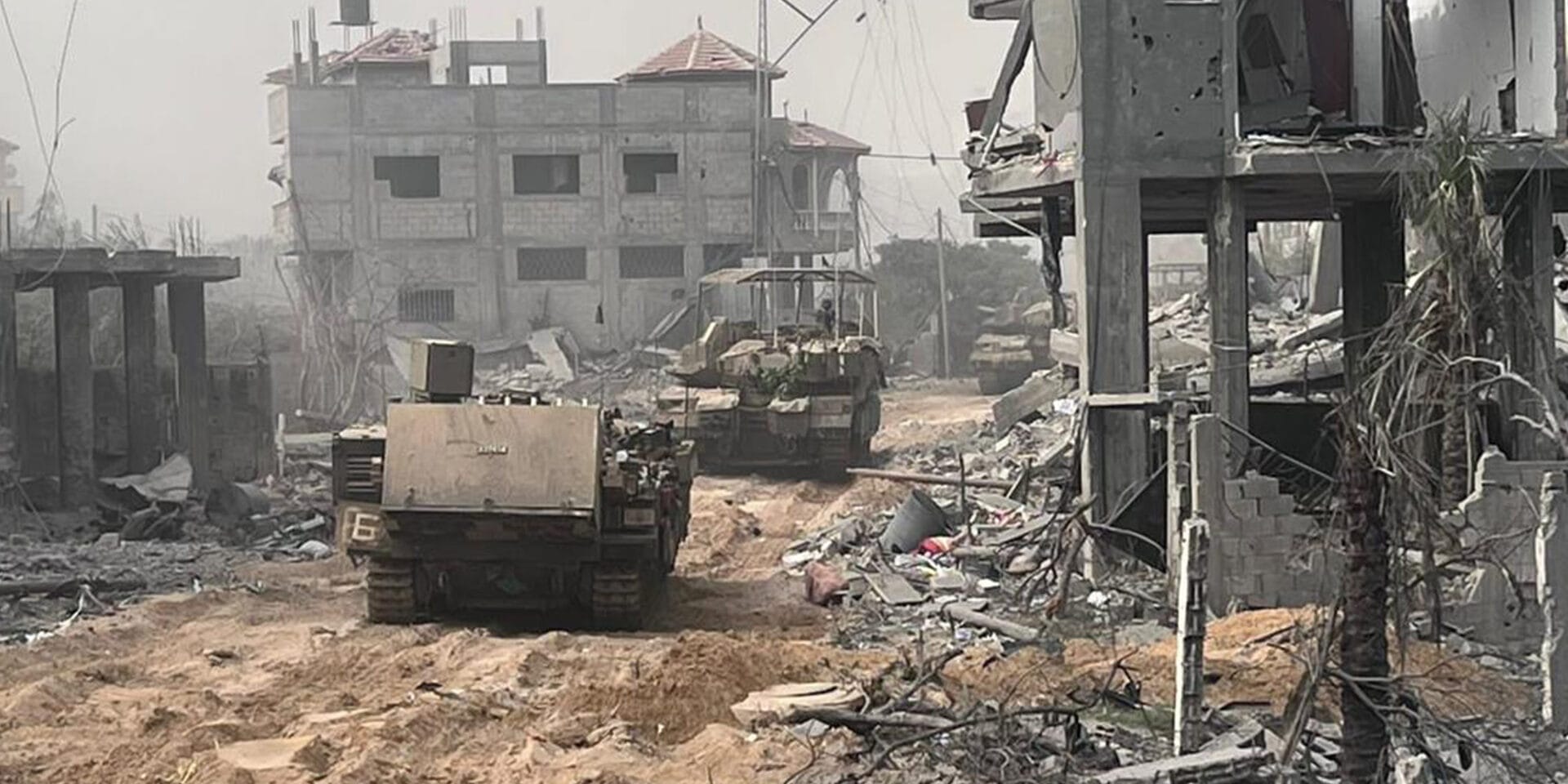
Satellites reveal farms devastated, nearly half of the territory’s trees razed, air and water pollution. Experts say Israel’s onslaught has made Gaza unlivable.
‘Ecocide in Gaza’:
Does Scale of Environmental
Destruction Amount to a War Crime?
Kaamil Ahmed, Damien Gayle and Aseel Mousa / Guardian UK
(March 29, 2024) — In a dilapidated warehouse in Rafah, Soha Abu Diab is living with her three young daughters and more than 20 other family members. They have no running water, no fuel and are surrounded by running sewage and waste piling up.
Like the rest of Gaza’s residents, they fear the air they breathe is heavy with pollutants and that the water carries disease. Beyond the city streets lie razed orchards and olive groves, and farmland destroyed by bombs and bulldozers.
“This life is not life,” says Abu Diab, who was displaced from Gaza City. “There is pollution everywhere — in the air, in the water we bathe in, in the water we drink, in the food we eat, in the area around us.”
For her family and thousands of others, the human cost of Israel’s invasion of Gaza, launched after the Hamas attack on 7 October, is being compounded by an environmental crisis.
The full extent of the damage in Gaza has not yet been documented, but analysis of satellite imagery provided to the Guardian shows the destruction of about 38-48% of tree cover and farmland.
Olive groves and farms have been reduced to packed earth; soil and groundwater have been contaminated by munitions and toxins; the sea is choked with sewage and waste; the air polluted by smoke and particulate matter.
Researchers and environmental organisations say the destruction will have enormous effects on Gaza’s ecosystems and biodiversity. The scale and potential long-term impact of the damage have led to calls for it to be regarded as “ecocide” and investigated as a possible war crime.
The Israel Defense Forces (IDF) says it follows international law and attempts to limit damage to agricultural areas and the environment.
“The IDF does not intentionally harm agricultural land and seeks to prevent environmental impact absent operational necessity,” it told the Guardian.

Gaza under attack: Trees, farms and homes destroyed.
‘Only Soil Left’
Satellite imagery, photos and video footage from the ground show how Gaza’s farmland, orchards and olive groves have been destroyed by the war.
He Yin, an assistant professor of geography at Kent State University in the US, who studied the damage to agricultural land in Syria during the 2011 civil war, analysed satellite imagery showing that up to 48% of Gaza’s tree cover had been lost or damaged between 7 October and 21 March.
As well as direct destruction from the military onslaught, the lack of fuel has led to people in Gaza having to cut down trees wherever they can find them to burn for cooking or heating.
“It’s whole orchards gone, only soil left; you don’t see a single thing,” Yin says.
Independent satellite analysis by Forensic Architecture (FA), a London-based research group that investigates state violence, found similar results.
Before 7 October, farms and orchards covered about 170 sq km (65 sq miles), or 47% of Gaza’s total land area. By the end of February, FA estimates from satellite data that Israeli military activity had destroyed more than 65 sq km, or 38% of that land.
As well as cultivated land, more than 7,500 greenhouses formed a vital part of the territory’s agricultural infrastructure.
Almost a third have been destroyed entirely, according to FA’s analysis, ranging from up to 90% in the north of Gaza to about 40% around Khan Younis.

‘What’s Left Is Devastation’
Samaneh Moafi, FA’s assistant director of research, describes the destruction as systematic.
Researchers used satellite imagery to document a repeated process in multiple locations, she says: after initial damage from aerial bombardment, ground troops arrived and dismantled greenhouses completely, while tractors, tanks and vehicles uprooted orchards and fields of crops.
“What’s left is devastation,” says Moafi. “An area that is no longer livable.”
FA’s investigation examined one farm in rast Jabalia, close to Gaza’s north-east border, cultivated by the Abu Suffiyeh family for the past decade. The family has since been displaced to the south. Their farm has been destroyed and orchards uprooted entirely, replaced by military earthworks with a new road carved through it.
“There is almost nothing to recognise there,” says one member of the family. “No traces of the land we knew. They totally erased it.
“It is now the same as it was before: desert … There is no single tree there. No traces of prior life. If I was to go there, I wouldn’t be able to recognise it.”
Israel has indicated it may attempt to make some of its demolitions permanent, with some officials proposing the creation of a “buffer zone” along the boundary between Gaza and Israel, where much of the agricultural land is located.
Some demolitions have already made way for Israeli military infrastructure. The open-source investigators Bellingcat say about 1,740 hectares (4,300 acres) of land appear to have been cleared in the area south of Gaza City where a new road, referred to by Israel as Route 749, has appeared, running across the entire width of the territory.
The Israeli military says the route was a “military necessity” built to “establish an operational foothold in the area and allow the passage of forces and logistical equipment”.
An IDF spokesperson said: “Hamas often operates from within orchards, fields, and agricultural land.” They added that: “The IDF is committed to mitigating civilian and environmental harm during operational activity.”
With trees razed, even the soil that remains is threatened by heavy bombing and demolitions. According to the UN Environment Programme (UNEP), heavy bombardment of populated areas can contaminate soil and groundwater in the long term — both through the munitions themselves and as collapsed buildings release hazardous materials such as asbestos, industrial chemicals and fuel into the surrounding air, soil and groundwater.
Since the beginning of the war, Israel has dropped tens of thousands of bombs on Gaza, with satellite analysis from January indicating that between 50% and 62% of all buildings had been damaged or destroyed.
As of January 2024, the UNEP estimated that bombing had left 22.9m tonnes of debris and hazardous material, with much of the rubble containing human remains.
“This is an extremely large amount of debris, especially for such a small area,” it says. “Components of the debris and rubble can contain harmful substances like asbestos, heavy metals, fire contaminants, unexploded ordnance, and hazardous chemicals.”

Piles of Waste and Poisoned Water
The area around the warehouse that Abu Diab rents with her family is a wasteland. Sewage leaks from a bombed-out home nearby and waste has piled up, as it has everywhere near the southern town of Rafah, which now hosts much of Gaza’s population.
“The sewage and waste around the house are a major tragedy. Cats and dogs are drawn to the waste, then spread it along the streets,” she says.
The continuing conflict and siege conditions have resulted in the total collapse of Gaza’s already fragile civil infrastructure, including waste disposal, sewage treatment, fuel supplies and water management.
Wim Zwijnenburg, who investigates the impact of conflicts on the environment for the Dutch peace organisation PAX, says: “War generally collapses everything. In Gaza, it’s making people exposed to additional risks from pollution, from polluted groundwater. It’s the destruction of anything the civilian population depends on.”
Gaza’s municipality has listed the damage to infrastructure, noting that 70,000 tonnes of solid waste had accumulated since 7 October. Impromptu landfills have sprouted around the territory as the volume of uncollected rubbish mounts, UNRWA, the UN refugee agency for Palestinians, which collects refuse in camps, is unable to operate. Zwijnenburg says PAX has identified at least 60 informal waste dumps in central and southern Gaza.
Ameer, a resident of Rafah, says people have become overwhelmed by pollution in the air as people use any wood or plastic to build fires, cars run on cooking oil, and from fumes left by the bombing itself.
“The smell is awful and the smoke coming from cars is unbearable — it made me sick for days,” he says. “The smell of gunpowder and these awful gases from the ongoing bombardments is doing both the people and the environment real harm.”
When Israel cut off fuel to Gaza after 7 October, the resulting power cuts meant wastewater could not be pumped to treatment plants, leading to 100,000 cubic metres of sewage a day spewing into the sea, the UNEP says.

‘An Act of Ecocide’
The scale and long-term impact of the destruction have led to calls for it to be investigated as a potential war crime, and to be classed as ecocide, which covers damage done to the environment by deliberate or negligent actions.
Under the Rome Statute, which governs the international criminal court, it is a war crime to intentionally launch an excessive attack knowing that it will cause widespread, long-term and severe damage to the natural environment The Geneva conventions require that warring parties do not use methods of warfare that cause “widespread, long-term and severe damage to the natural environment”.
Saeed Bagheri, a lecturer in international law at Reading University, says that while there are disagreements about how to apply these articles, there are enough grounds to investigate the damage done to Gaza’s environment already.
Abeer al-Butmeh, the coordinator of the Palestinian Environmental NGOs Network, says: “The Israeli occupation has completely damaged all elements of life and all environmental elements in Gaza — they completely destroyed the agriculture and wildlife.
“What is happening is, for sure, ecocide,” she says. “[It] is completely damaging the environment in Gaza for the long term, not only for the short term.
“Palestinian people have a strong relationship with the land — they are very connected to their land and also to the sea,” she says. “People in Gaza cannot live without fishing, without farming.
FA says: “The destruction of agricultural land and infrastructure in Gaza is a deliberate act of ecocide.
“The targeted farms and greenhouses are fundamental to local food production for a population already under a decades-long siege. The effects of this systematic agricultural destruction are exacerbated by other deliberate acts of deprivation of critical resources for Palestinian survival in Gaza.”
Posted in accordance with Title 17, Section 107, US Code, for noncommercial, educational purposes.